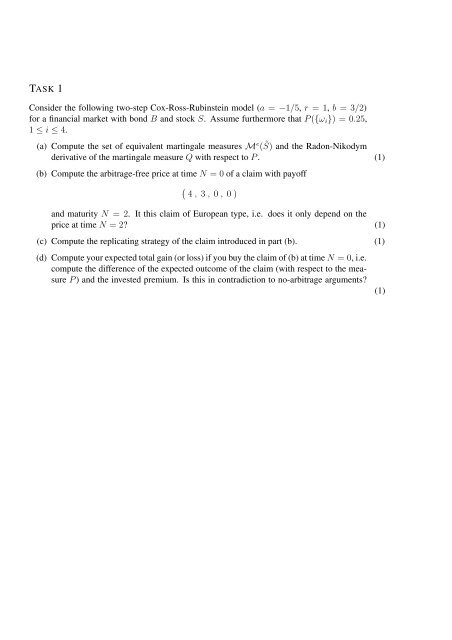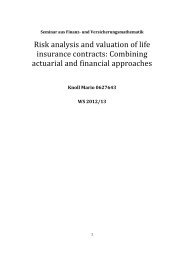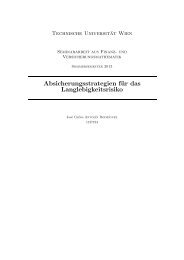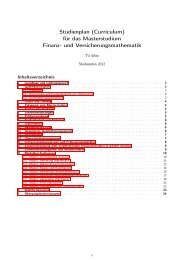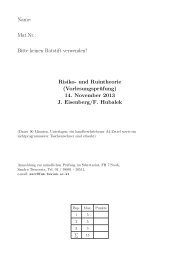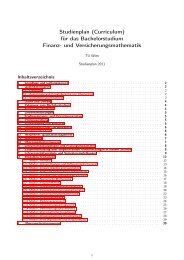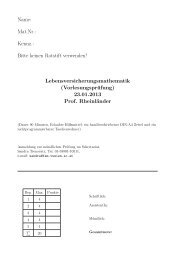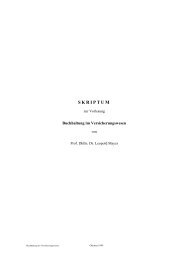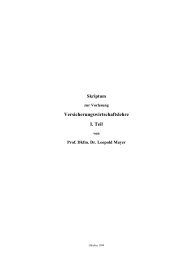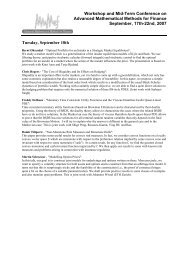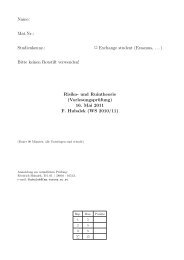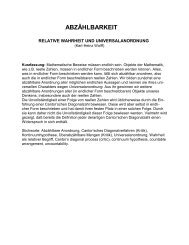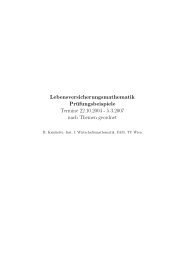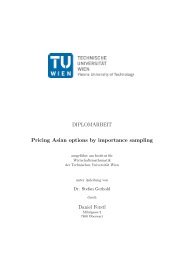TASK 1 Consider the following two-step Cox-Ross-Rubinstein ... - FAM
TASK 1 Consider the following two-step Cox-Ross-Rubinstein ... - FAM
TASK 1 Consider the following two-step Cox-Ross-Rubinstein ... - FAM
You also want an ePaper? Increase the reach of your titles
YUMPU automatically turns print PDFs into web optimized ePapers that Google loves.
<strong>TASK</strong> 1<br />
<strong>Consider</strong> <strong>the</strong> <strong>following</strong> <strong>two</strong>-<strong>step</strong> <strong>Cox</strong>-<strong>Ross</strong>-<strong>Rubinstein</strong> model (a = −1/5, r = 1, b = 3/2)<br />
for a financial market with bond B and stock S. Assume fur<strong>the</strong>rmore that P ({ωi}) = 0.25,<br />
1 ≤ i ≤ 4.<br />
(a) Compute <strong>the</strong> set of equivalent martingale measures M e ( ˜ S) and <strong>the</strong> Radon-Nikodym<br />
derivative of <strong>the</strong> martingale measure Q with respect to P . (1)<br />
(b) Compute <strong>the</strong> arbitrage-free price at time N = 0 of a claim with payoff<br />
4 , 3 , 0 , 0 )<br />
and maturity N = 2. It this claim of European type, i.e. does it only depend on <strong>the</strong><br />
price at time N = 2? (1)<br />
(c) Compute <strong>the</strong> replicating strategy of <strong>the</strong> claim introduced in part (b). (1)<br />
(d) Compute your expected total gain (or loss) if you buy <strong>the</strong> claim of (b) at time N = 0, i.e.<br />
compute <strong>the</strong> difference of <strong>the</strong> expected outcome of <strong>the</strong> claim (with respect to <strong>the</strong> measure<br />
P ) and <strong>the</strong> invested premium. Is this in contradiction to no-arbitrage arguments?<br />
(1)
<strong>Consider</strong> a <strong>two</strong>-<strong>step</strong> model for a financial market with bond B and stock S. The bond B and<br />
<strong>the</strong> stock S are assumed to move according to <strong>the</strong> <strong>following</strong> tree:<br />
B0 = 1 ✲B1 = 3/2 ✲ B2 = 2<br />
S2 = 18<br />
S1 = 9/2<br />
✘<br />
S0 = 1<br />
S2 = 9/2<br />
S1 = 9/8 S2 = 9/8<br />
S2 = 1/2<br />
✘✘✘✘✿<br />
✘<br />
❳ ❳❳❳❳③<br />
✘✘✘✘✘✿ ❳ ❳❳ ❳❳③<br />
✘✘✘✘✿<br />
❳ ❳❳❳❳③<br />
✲<br />
Assume fur<strong>the</strong>rmore that P ({ωi}) = 0.2, 1 ≤ i ≤ 5.<br />
(e) Compute <strong>the</strong> set of equivalent martingale measures M e ( ˜ S) as well as <strong>the</strong> set of absolutely<br />
continuous martingale measures M a ( ˜ S). (1)<br />
(f) Compute <strong>the</strong> arbitrage-free price(s) at times n = 0, 1 of a European put option with<br />
strike K = 9/4 and maturity N = 2. Apply <strong>the</strong> put-call parity to calculate <strong>the</strong> prices of<br />
a European Call option. (1)
<strong>TASK</strong> 2<br />
<strong>Consider</strong> a Bachelier Model with constant interest rate r = 0 and stock price S, i.e. under <strong>the</strong><br />
martingale measure Q <strong>the</strong> stock price process is given by<br />
St = S0 + σBt, S0, σ > 0, 0 ≤ t ≤ T.<br />
Here, B denotes a standard Brownian motion under <strong>the</strong> martingale measure Q.<br />
(a) Compute <strong>the</strong> arbitrage-free price v of an option with payoff<br />
1ST ≥S0,<br />
i.e. which pays one if ST ≥ S0 and 0 o<strong>the</strong>rwise. (2)<br />
(b) Find a replicating strategy (φt) 0≤t≤T for <strong>the</strong> option, i.e. solve <strong>the</strong> equation<br />
1ST ≥S0 = v +<br />
T<br />
0<br />
φsdSs.<br />
Write down <strong>the</strong> Hedging portfolio for <strong>the</strong> option and calculate <strong>the</strong> amount of money<br />
at each time in <strong>the</strong> Bank account. Recall that <strong>the</strong> derivative of <strong>the</strong> price v for time to<br />
maturity T − t at <strong>the</strong> actual price St yields <strong>the</strong> hedging portfolio. (2)
<strong>TASK</strong> 3<br />
<strong>Consider</strong> a Black-Scholes Model with constant interest rate r = 0 and stock price S, i.e. under<br />
<strong>the</strong> martingale measure Q <strong>the</strong> stock price process is given by<br />
St = S0 exp(− σ2 t<br />
2 + σBt), S0, σ > 0, 0 ≤ t ≤ T.<br />
Here, B denotes a standard Brownian motion under <strong>the</strong> martingale measure Q.<br />
(a) Compute <strong>the</strong> arbitrage-free price p of <strong>the</strong> scaled European put option with payoff<br />
(0.01ST − K)−.<br />
How does <strong>the</strong> put-call parity look for this type of option? (2)<br />
(b) Calculate actual prices for S0 = 100, K = 1, σ = 0.2, T = 0, 5 and <strong>the</strong> actual hedging<br />
portfolio in this case. (2)


